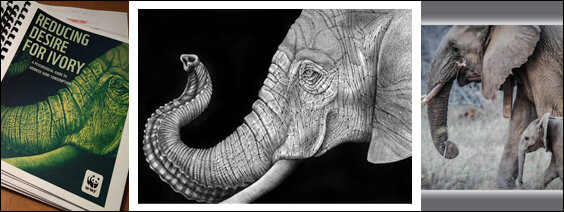4 Reasons Why the Environment Needs Elephants
Elephants are a keystone species that need protection
It was an incredible honor to have my elephant drawing on the cover of the World Wildlife Fund's (WWF) "Guide to Reducing Desire for Ivory Consumption". The importance of this cause is imperative to stopping illegal and unsustainable wildlife products, and making the world safe for elephants to live. I am so humbled to know I can contribute to this wonderful effort through my artwork. Thank you to Jan Vertefeuille, Renee Lertzman, PhD, and the WWF for all your tireless work in making the world a better place!
Below are 4 incredibly important reasons why the environment needs elephants. Written by Brielle Albert who is a talented writer and digital marketing professional and earned her Bachelor of Science Degree at New York University. She has professional experience in social media marketing and copywriting. I want to thank Brielle for her efforts in sharing these extremely important reasons why elephants need to be protected.
4 Reasons Why the Environment Needs Elephants
By Brielle Albert
Elephants are considered to be a keystone species. This means that if they are removed from an ecosystem, the rest of that ecosystem will collapse. Despite this, their numbers are dwindling. There are only 415,000 wild African elephants remaining, with even fewer - 50,000 at most - of their Asian cousins. There are many reasons why the environment needs elephants; this article explains four of the most important.
Elephants are not only beautiful creatures, they are also pivotal to the wellbeing and continuation of the ecosystems in which they live. You can support protecting elephants by educating people about their importance, advertising the wonder of these animals by wearing something like an elephant bracelet, and making sure that you don’t buy products that contain ivory.
1. Sourcing water
Of course, water is vital to all living things. When the weather conditions are dry for a long period, the lack of water causes problems for all species, particularly large animals like elephants. Using their ivory tusks, elephants dig ‘wells’ in the ground in order to access water below the surface. This not only provides them with what they need but also allows other animals to get much-needed water too.
2. Providing food
As elephants walk many miles each day, they leave their droppings behind them. This is a source of food for various insects and provides nutrients for plants and fungi that, in turn, are food for other species in the ecosystem. Dung beetles also collect the elephants’ droppings and raise their larvae inside them; these larvae are eaten by honey badgers, amongst other animals. It is all part of the complex food web.
As well as that, when elephants pull down branches to eat the leaves or bark, they’re also moving fruit and flowers to lower positions. This means that smaller animals can access these when they wouldn’t otherwise be able to.
3. Dispersing seeds
Some plants rely entirely on elephants for their dispersal of seeds. Without this, seeds wouldn’t be spread around, and so new plants wouldn’t grow. This would not only severely harm the food chain but would also add to the greenhouse effect. Whenever an elephant consumes seeds, it will later deposit these elsewhere in its dung. Studies have shown that elephants can disperse seeds as much as 40 miles away from where they were collected!
4. Building habitats
It is not only through spreading seeds around that elephants help to create new habitats. Additionally, when they pull down trees or branches, they make gaps in the canopy. This gives space and light for new plants to grow. Forest elephants also create pathways through the dense vegetation that other animals can use. All of this promotes biodiversity; this, in turn, enhances the ecosystem and allows more plants and animals to thrive.
Photograph of Elephants credit: Casey Allen

